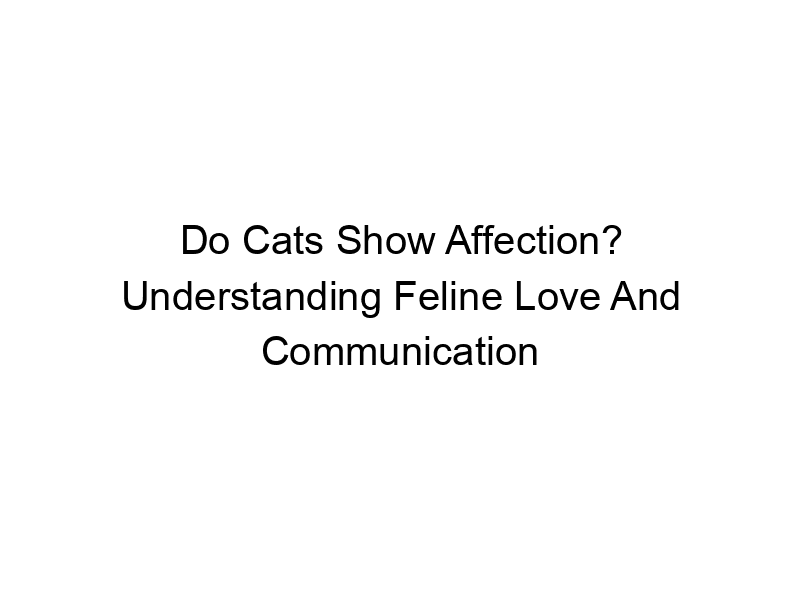Do cats really love their owners? This is a question that has puzzled cat lovers for generations. Do Cats Really Love Their Owners? Understanding Feline Affection delves into the complexities of feline behavior, exploring how cats express affection, the science behind their bonds with humans, and common misconceptions surrounding their emotional lives. This in-depth guide will cover various ways cats communicate love, the differences between cat breeds, and how to best understand your feline companion’s unique personality. Prepare to learn about the surprising ways your cat might be showing you how much they care!
Cats communicate through a complex interplay of body language, vocalizations, and scent. Unlike dogs who often express affection overtly, cats are more subtle. A slow blink, often interpreted as a “cat kiss,” is a
classic example of feline affection. A relaxed posture, with a slightly lowered head and a slow tail wag, also indicates comfort and trust. Conversely, a puffed-up tail, flattened ears, or hissing signifies fear or aggression, the opposite of affection.
The Significance of Purring
The purr, a low rumbling sound, is often associated with contentment and happiness. However, cats may also purr when they are in pain or stressed, as a self-soothing mechanism. The context is crucial to interpreting the meaning behind a purr. A purr accompanied by a slow blink and relaxed body language likely indicates affection, while a purr alongside other signs of distress suggests a different situation.
The Science of Cat-Human Bonds
Oxytocin and the Role of Hormones
Research shows that the hormone oxytocin, often called the “love hormone,” plays a significant role in the bond between cats and humans. Studies have shown increased oxytocin levels in both cats and humans after interactions involving mutual grooming or petting. This hormonal release reinforces positive interactions and strengthens the bond.
Individual Cat Personalities
Just like humans, cats have diverse personalities. Some cats are naturally more affectionate than others. Breeds such as Ragdolls and Persians are often known for their cuddly nature, while others, like Siamese, may be more independent. Understanding your cat’s individual personality is key to deciphering their expressions of affection.
How Cats Show Affection: A Diverse Range of Behaviors
Slow Blinks and Head Boops
The slow blink, as mentioned earlier, is a powerful sign of trust and affection. It’s essentially a feline way of saying “I love you” or “I feel safe with you.” A head boop, where a cat gently bumps their head against you, is another affectionate gesture. It’s a sign of marking you as part of their territory and showing acceptance.
Kneading and Purring
Kneading, also known as making biscuits, is a behavior cats retain from kittenhood. They knead on their mothers’ bellies to stimulate milk production. As adults, they often knead on soft surfaces or their human companions as a sign of comfort and contentment. Combined with purring, it’s a clear indication of affection.
Interpreting Your Cat’s Actions: Context is Key
Situational Analysis: Understanding the Environment
To properly understand your cat’s behavior, consider the context. A cat that usually rubs against your legs might avoid you if they are feeling unwell or stressed. Similarly, a normally affectionate cat might be less cuddly during a thunderstorm or if there are unfamiliar people or animals around.
Recognizing Subtle Signs
Pay close attention to subtle cues. Does your cat follow you around the house? Do they sleep near you? These seemingly small actions can be indicators of a strong bond. A cat who seeks your company and enjoys being petted is showing their affection in a way that aligns with their personality.
Common Misconceptions about Feline Affection
Myth 1: Cats are Independent and Don’t Need Human Companionship
While cats are often described as independent, this doesn’t mean they don’t crave companionship. Many cats form deep bonds with their owners, seeking their attention and affection. The misconception arises from their self-sufficient nature compared to more overtly dependent animals like dogs.
Myth 2: All Cats Express Affection in the Same Way
As mentioned earlier, cats have diverse personalities. What one cat considers affectionate behavior, another might find intrusive. Some cats are more vocal, while others show affection through subtle body language cues. Understanding individual differences is essential to interpreting your cat’s behavior.
Building a Stronger Bond with Your Feline Friend
Creating a Safe and Comfortable Environment
A secure and enriching environment is vital for building a strong bond with your cat. Provide plenty of scratching posts, toys, and resting places. A consistent routine and plenty of opportunities for play and interaction will strengthen your bond.
Understanding Your Cat’s Preferences
Spend time observing your cat’s behavior and preferences. Does your cat prefer gentle petting or vigorous play? Does your cat enjoy being held or does it prefer to be near you without physical contact? Respecting your cat’s individual needs is crucial to building a trusting relationship.
Beyond the Basics: Advanced Understanding of Feline Behavior
The Role of Scent Marking in Cat Relationships
Cats use scent marking as a way of communicating ownership and affection. Rubbing their bodies against you or furniture is a way of leaving their scent, essentially claiming you as part of their territory and social group. This is a subtle yet significant expression of affection.
Exploring Different Cat Breeds and Temperaments
Different cat breeds exhibit varying levels of affection and sociability. Some breeds, such as Siamese cats, are known for their vocalizations and demanding personalities, while others, like British Shorthairs, are more reserved and independent. Understanding your cat’s breed can provide insights into their typical behavior and expression of affection.
Frequently Asked Questions
What are the most common ways cats show love to their owners?
Cats express love in various ways, including slow blinks, head boops, kneading, purring, rubbing against their owners, following them around the house, and sleeping near them. These behaviors signify trust, comfort, and contentment. The best way to understand your cat’s specific ways of showing affection is to pay close attention to its unique personality and behavior patterns.
Do all cats bond with their humans?
While most cats form bonds with their human companions, the depth and expression of this bond can vary greatly depending on factors such as the cat’s personality, breed, and the quality of the interaction with its human. Some cats might be more independent, but even those cats can develop a close relationship with their humans based on trust and mutual respect. A consistent and positive environment plays a crucial role in establishing a strong bond.
Final Thoughts
Understanding feline affection requires patience, observation, and a willingness to learn. Cats may not express love in the same way as dogs, but their subtle gestures and unique behaviors are clear indicators of a bond. By understanding feline communication, recognizing subtle cues, and creating a safe and enriching environment, you can nurture a deeper connection with your feline companion. Remember, every cat is an individual, with its own unique personality and way of expressing affection. By observing your cat closely, learning its specific cues, and adapting your approach accordingly, you can deepen your understanding of your cat’s unique ways of showing love and building a strong, lasting bond. Observe your cat’s actions, listen to its vocalizations, and cherish every purr, slow blink, and head boop – these are the signs of a loving cat-human relationship.




